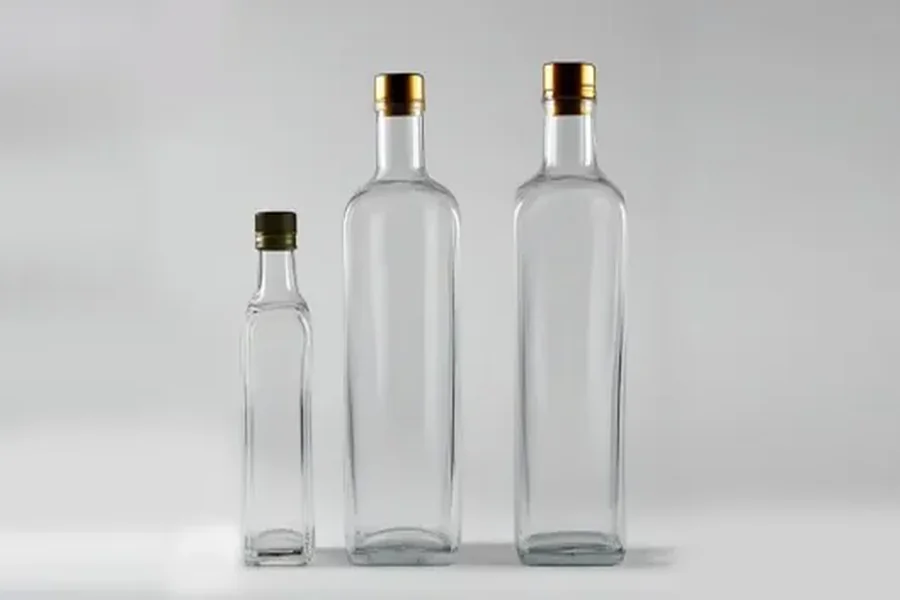Not only can the bottle’s content make a difference, but the atmosphere in a liquor bar is important as well. Your bottle? The first contact for a customer is through the product’s packaging, which is why partnering with a custom glass liquor bottle manufacturer is key. Today, let’s go over the best ways to bring your brand’s character to a unique bottle.
Why Go Custom for Your Liquor Bottle?
A Unique Look = Instant Brand Recognition
If something is interesting enough, you’ll probably remember it, such as an uncommon bottle or a gorgeous black coating. How you design your bottle may really help people remember your brand.
Custom Design Adds Perceived Value
When creating a luxury product, the look of the bottle should make it seem expensive as well. That’s where partnering with a premium glass bottle factory becomes essential—they transform your vision into tangible elegance, ensuring every curve, thickness, and finish reflects your brand’s sophistication.
Creating that eye-catching bottle involves some strategic moves. Here’s the full roadmap from concept to shelf.
1. Define Your Brand Personality
What Story Are You Telling?
Is your brand bold and edgy? Elegant and timeless? Rustic and traditional? Nail this down early, because your bottle needs to reflect your vibe. A high-end gin brand won’t use the same bottle style as a Caribbean rum.
2. Choose the Right Bottle Shape
Glass Blowing Isn’t Just for Art
750ml is the standard size for spirits, which gives you room to play with shapes. Do you want smooth curves, sharp edges, a thick base, or a long neck?
Popular Bottle Shapes:
- Tall and Sleek (Perfect for vodka or gin)
- Short and Stout (Think of craft whiskey or mezcal)
- Decanter Style (Adds a touch of luxury)
- Square or Custom Molded (Modern and bold)
Tip: Sketch out rough visual ideas or browse existing bottles for inspiration before meeting a designer. It’s much easier to move fast when you’re clear on direction.
3. Work With a Bottle Manufacturer
Don’t DIY This
You’ll need experts. Look for manufacturers who specialize in custom glass bottles for liquor. Ask about minimum order quantities (MOQs), lead times, pricing tiers, and whether they offer in-house design support.
Recommended Manufacturers:
- Saverglass
- O-I Glass
- Vitro Packaging
- All American Containers
Make sure they can handle your preferred shape, embossing, and materials.
4. Nail the Technical Specs
Size, Volume & Weight Matter
Stick with 750ml for standard retail, but consider:
- Glass thickness (thicker = more premium feel)
- Bottle height and width (impacts box/pallet sizes)
- Mouth opening (especially important if using corks vs screw caps)
Compliance Is Key
Your bottle must meet both functional and legal standards – this includes labeling laws (more on that later), closure safety, and packaging regulations based on your target markets.
5. Design the Label – or Go Labelless
Label First, Then Logo
Start with your label layout before you even finalize logo placement. This ensures everything flows together—font, color, and spacing.
Label Design Tips:
- Typography should reflect your brand (Elegant serif for heritage, bold sans-serif for modern)
- Pick ONE focal point (Don’t clutter your label)
- Matte, foil, or embossed finishes can add serious wow factor
No Label? No Problem
Etching, screen printing, and embossing the design right onto the glass is a rising trend. It looks super sleek and feels luxurious in hand.
6. Choose the Closure: Cork, Cap, or Custom?
The Cap Tells a Story Too
- Synthetic corks: Modern with a traditional feel
- Natural corks: Give premium vibes (but can be pricey and fragile)
- Screw caps: Functional and timeless
- Custom closures: Think wax seals, wood tops, or even gemstone-like finishes
Just make sure the seal is firm and leak-proof. Nothing will kill your brand faster than a leaky bottle in transit.
7. Add Custom Embossing or Texture
Make It Touchable
Adding a raised logo, name, or pattern directly on the glass boosts tactile appeal. Think of it like branding your product into the very bones of the bottle.
Whether it’s a signature swirl, crest, or unique texture… this is where you separate from the pack.
8. Consider the Packaging
Boxes, Tubes, and Display Cases
Don’t stop at the bottle — premium spirits demand premium packaging. Think:
- Silk-lined boxes
- Minimalist tubes
- Wooden cases
- Slide-out drawer boxes
Not only does great packaging protect the bottle, but it also enhances giftability and presentation.
9. Legal Label Requirements (U.S. Market)
Even if your bottle looks like a piece of art, it still has to follow the rules.
What You Must Include:
- Brand name
- Alcohol by volume (ABV)
- Net contents (750ml)
- Government warning
- Produced/bottled/distilled statements
- Country of origin
- Barcode / UPC
Check regulations for both federal (TTB in the U.S.) and state markets if you’re planning to sell widely.
10. Test Your Bottle Design
Prototype First, Then Go Big
Always get a prototype before mass production. Look for:
- Visual flaws (cloudy glass, misaligned embossing)
- Label placement accuracy
- Sealing performance (open and close it multiple times)
- In-hand feel and weight (does it “feel expensive”?)
Better to fix issues now than after 10,000 are made.
11. Work with a Design Agency (Optional but Smart)
While you can try designing yourself, pros know how to make a bottle “talk.” They’ll help with:
- 3D renderings
- Mockups for investors
- Color and foil guides
- Label print setup files
12. Plan Logistics and Storage
Yes, You Need Space. Lots of It.
Glass is heavy and fragile. You’ll need:
- Climate-controlled storage
- Safe transport methods
- Reliable freight carriers
Bulk bottles are often palletized – each pallet can weigh over 1,000 pounds, so prep your warehouse or garage accordingly.
13. Cost Breakdown: What You Can Expect
Here’s a rough idea:
- Custom bottle mold: 5,000–5,000–15,000 (one-time expense)
- Per-bottle cost: 1.20 1.20–3.00 (varies with customization)
- Closure: 0.10–0.10–0.50 each
- Label printing: 0.15–0.15–0.80 per label
- Packaging: 1.00–1.00–4.00 per unit
The more extras you add, the higher the cost — but the more impressive the end product.
14. Create a Signature Experience
It’s not just what your bottle looks like. It’s how it feels to open. To hold. To pour. That entire experience can turn customers into brand loyalists.
15. Launch With a Bang
Tell Your Story Everywhere
Show off behind-the-scenes of designing the bottle on social, your website, and at launch events. People love seeing the evolution of a product — especially when there’s craftsmanship behind it.
Conclusion: Your Custom Bottle is Your Silent Salesperson
Your 750ml custom liquor bottle is way more than a container. It’s a handshake. A conversation starter. A promise of quality. Don’t treat it as an afterthought — craft it like it’s the heart of your brand (because honestly, it kind of is).
Whether your dream is a rebellious rum bottle with skull embossing or a sleek gin bottle dipped in custom-painted matte navy, one thing’s for sure: custom is never just about looks — it’s about lasting impact.






